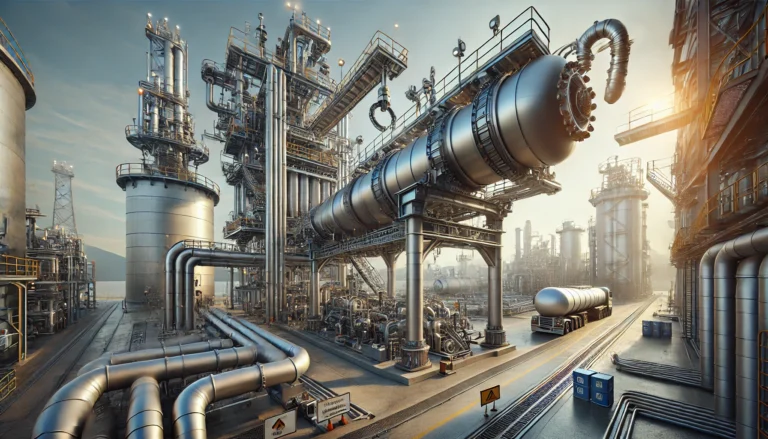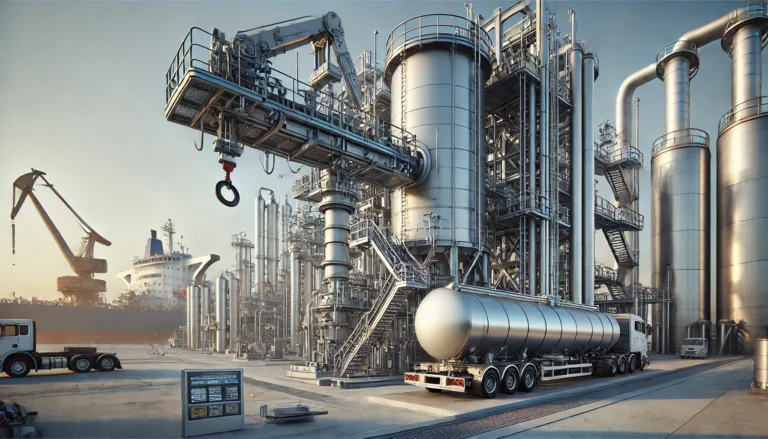In the oil, chemical, and energy transportation industries, the term “loading arm” (also known as liquid unloading arms) is commonly encountered. It is an indispensable piece of equipment in liquid material handling systems, widely used for transporting flammable, explosive, or toxic liquids due to its safe, efficient, environmentally friendly, and sealed loading and unloading capabilities.
This article will provide an in-depth understanding of the definition, working principle, structural components, classifications, usage and maintenance standards of loading arms, and address the frequently asked question—Is a loading arm considered a special equipment?
1. Definition and Working Principle of a Loading Arm
A loading arm (Loading Arm) is a mechanical arm device specifically designed for the loading and unloading of liquid or gas media. It utilizes a rotating joint and multiple rigid pipelines to allow flexible extension and sealed connection.
The working principle involves a combination of a balancing system and rotating joint that enables the arm to move freely in three-dimensional space. This allows safe connections between tanks, trailers, pipelines, etc., and ensures smooth loading and unloading of media. During the liquid flow process, the sealing structure of the loading arm effectively prevents leakage and evaporation, ensuring safe, clean, and environmentally friendly operations.
Compared to traditional hose-based unloading methods, loading arms use hard connections with rotational joints, which not only improve safety but also significantly increase operational efficiency and equipment lifespan.

2. Structural Components and Technical Features
A standard loading arm consists of the following key components:
Rotating Joint (Swivel Joint): A crucial part for multi-angle rotation, equipped with seals to prevent leakage.
Inner and Outer Arms: Responsible for supporting and directing the flow, bearing the media pressure.
Vertical Tube System: The terminal section connecting to the trailer or tank, often designed with telescopic, sealed, or vent functions.
Balancing System: Uses springs or gas balancing devices to offset the weight of the arm, making operations light and flexible.
Emergency Release Coupler: Automatically disconnects in emergencies to prevent accidents caused by excessive tension.
These components together ensure the loading arm’s exceptional safety, flexibility, and durability.
3. Applications and Industry Value
Loading arms play a critical role in various industries, particularly in:
Petrochemical Industry: Used for loading and unloading gasoline, diesel, ethanol, methanol, liquefied petroleum gas, ammonia, and other media.
Liquid Storage and Transport Industry: Facilitates fluid transfer between storage tanks, trailers, and ships.
Fine Chemicals and Pharmaceutical Industry: Used for closed transfer of high-purity or corrosive media.
Ports and Energy Bases: Ship-mounted loading arms are crucial in LNG and chemical terminals.
Using loading arms ensures sealed loading and unloading, energy conservation, emission reduction, and pollution prevention, thereby enhancing safety and environmental compliance in industries.
4. Detailed Classifications of Loading Arms
By Material:
Carbon Steel Loading Arms: Suitable for ambient temperature and common chemical media.
Stainless Steel Loading Arms: Corrosion-resistant, suitable for acidic, alkaline, and toxic chemicals.
By Medium Type:
Gasoline, Diesel, Liquid Chlorine, Liquefied Gas, Methanol, Propylene Loading Arms, etc.
By Usage Scenario:
Land-Based Loading Arms: Used for truck and railcar loading/unloading.
Marine Loading Arms: Used for fluid transfer between ships and storage tanks at docks.
By Technical Features:
PTFE-Lined Loading Arms: For handling highly corrosive media.
Cryogenic Loading Arms: Designed for LNG or low-temperature media like liquid oxygen or nitrogen.
Heated Loading Arms: Suitable for viscous or solidifying media such as asphalt and heavy oil.

5. Installation and Usage Considerations
The installation and usage of loading arms directly impact safety and equipment lifespan. The following considerations are important:
For corrosive media, use a sealed bottom loading method to prevent splashing.
Volatile media should be loaded using a closed system with a vent return pipe.
Flammable media should be equipped with nitrogen seals or balancing pipes to maintain vapor phase balance.
Cryogenic or high-viscosity media require a heating system to prevent freezing or reduced fluidity.
Ensure the loading platform provides the correct operational height, safety distance, and recovery space to prevent overreach or collision.
6. Routine Maintenance and Safety Management
Regular Lubrication and Inspection: Apply lubricating oil to rotating joints and support points to reduce wear.
Leak Detection: Replace seals and clean the rotary device immediately if leakage occurs.
Emergency Release Coupler Testing: Test the coupler’s sensitivity regularly to ensure it disconnects rapidly during emergencies.
Operator Training: Operators should undergo systematic training to understand loading/unloading procedures and emergency response methods.
Annual Maintenance: It is recommended to conduct safety performance testing and maintenance by a professional manufacturer every year.
7. Is a Loading Arm Considered Special Equipment?
This is a common question among businesses.
According to the Special Equipment Safety Law of the People’s Republic of China and the Special Equipment Catalog (2024 Revision), loading arms are not classified as special equipment. Special equipment primarily includes boilers, pressure vessels, pressure pipelines, elevators, lifting machinery, passenger ropeways, large amusement facilities, etc.
However, loading arms are often used in the handling of hazardous chemical media that are flammable, explosive, toxic, or corrosive. Therefore, safety management standards similar to those applied to special equipment should be followed. Companies should design, install, and use loading arms according to the Safety Technical Regulations for Dangerous Chemicals Loading and Unloading (GB 15594-2016), regularly check seal performance and static grounding systems, and include loading arms in the company’s safety risk list and annual safety inspection plan.
In conclusion, while loading arms are not legally classified as special equipment, they should be treated with the same level of safety and regulatory attention.

8. Conclusion
As a crucial component in liquid handling systems, loading arms play a vital role in industries like petrochemical, chemical storage, and transportation. Their safety, efficiency, and environmental benefits are undeniable. While not legally classified as special equipment, they should be managed and maintained according to the same stringent standards to ensure operational safety.
With the ongoing industry trend of “safety first, green and low-carbon operations, and intelligent control,” loading arms will continue to be an irreplaceable and essential piece of equipment in industrial loading and unloading operations.
